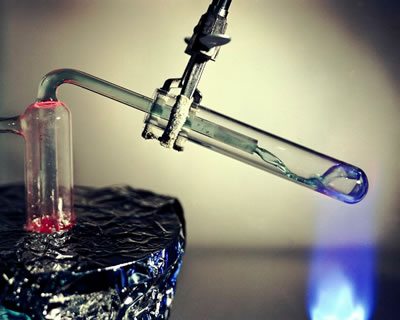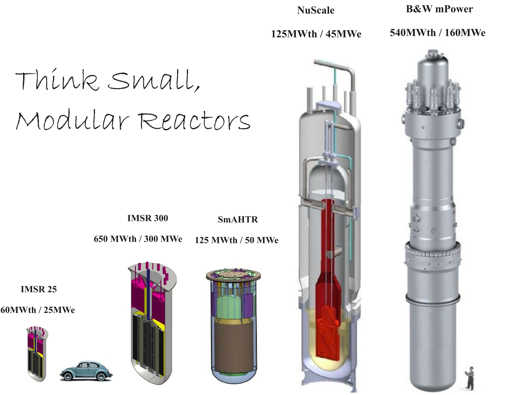It’s always nice to write about technological innovation coming from your own country. So today I’m happy to introduce you to Canada’s current and future contribution to the nuclear energy mix.
Canada produced the CANDU reactor in the 1950s, its contribution to current nuclear energy power plant technology. CANDU was different from other nuclear power plants. It used heavy water, deuterium, as the coolant in its plants. Today massive CANDU reactors are operating in a number of countries. They are, however, expensive to build, require a long regulatory process and require regular refits that can run up a pretty big bill just like all other contemporary nuclear reactor technologies. And unfortunately, as we found out when India became a nuclear power, CANDU technology can be used to create nuclear fuel for bombs. For many years CANDU was the only play in town for Canadian utilities. CANDU was a product owned by a crown corporation, the Atomic Energy Commission. Recently, however, the Commission was directed to sell its reactor business to an engineering company – SNC Lavalin. But in Canada CANDU is no longer the only game in town. There are two others.
One is General Fusion, a Vancouver based private venture capital financed company that is developing what it calls magnetized target fusion with the goal to build a full-scale fusion demonstrator, a precursor to a commercial reactor. It’s probably a decade-and-a-half away from completion so for the moment we will put it aside.
The second company, however, is one that recently announced its plans to build a molten salt reactor, and it is 8 years away from creating a commercial product. This “newbie” is Terrestrial Energy, just founded in 2012, is located in Ottawa, Canada’s capital. The company plans to bring to market what it calls an Integral Molten Salt Reactor or IMSR by 2021.
I have written about MSRs before citing a recently formed U.S. company as well as describing efforts by the Chinese government to build an operational commercial reactor. But what makes Terrestrial different is the size of the technology it intends to deliver. Each IMSR will be small and modular. See the picture below with an IMSR next to a Volkswagen Beetle and you get an idea of just how small these nuclear reactors are. Individual IMSRs may generate as little as 50 Megawatts. Grouped together and you can grow capacity to as much as 600 Megawatts. IMSR is flexible, designed to be a point-of-demand energy solution that can be placed in areas where current nuclear technology would be a “no go.”
IMSR is next generation nuclear power. The molten salt acts as both fuel and coolant. It operates at ambient pressure and can burn a wide variety of nuclear fuels including spent nuclear waste, currently one of the biggest storage challenges the industry faces. Terrestrial intends to run its initial IMSR on uranium (these can be spent rods) although thorium can be used as well. Terrestrial describes its IMSRs cohabiting with renewable energy facilities like solar and wind. In such a combination a utility could produce continuous, clean, fossil-fuel free energy with no carbon footprint. Even oil sands producers are looking at IMSR for local power requirements so that they can reduce their carbon footprint.
Molten salt reactors are safer than any other reactor technology. They operate under ambient pressure so you won’t see a radioactive hydrogen gas explosion like the one that occurred at Fukushima Daiichi after the tsunami flooded the facility causing the pumps to fail and the water in the containment building to drop precariously exposing the core leading to a partial meltdown. In contrast when an IMSR stops working there is no meltdown. Instead the molten salt cools and solidifies with the nuclear fuel safely contained within it.











There are new reactor designs aplenty all over the world. But one should keep in mind that the principal constraints in reactor design are not actually technical, but rather governmental and economical. Huge investments are required to produce nuclear fuel before any reactor design can ever go critical. Some means must be implemented either for U-235 isotopic enrichment or for initiating controlled fission in natural uranium. All uranium enrichment plants are strictly regulated and completely controlled by governments that either have or are seeking nuclear weapons.
The old Canadian CANDU design substitutes investment in heavy water production for investment in isotopic separation/enrichment. Hence, CANDU reactor designs, which are moderated by Canadian produced heavy water, can “burn” natural un-enriched uranium. Only large amounts of natural uranium can produce a “critical mass” that will sustain a nuclear chain reaction. Power density must necessarily be lower. However, unenriched reactor designs breed five or six times as much plutonium per thermal unit produced. That is a logical step on the path to nuclear weapons. The CANDU design arose in a time when Canada had surplus heavy water production capacity, gaseous diffusion cascades were the only feasible technology for fuel enrichment, and the Western Nations were eager to obtain more plutonium for nuclear weapons.
Eventually cascades of advanced centrifuge designs proved more economical than gaseous diffusion enrichment methods and plutonium became super abundant. So economics of power production forced abandonment the un-enriched natural uranium designs in favor of large water-cooled and moderated enriched fuel (3.5-5%) designs. (Small naval reactors requiring fuel enrichment above 50% U-235 being an exception, but there the costs per thermal unit are likely ten times greater than in commercial reactors.)
The whole nuclear power industry is now at a tipping point. Smaller safer designs are only possible to implement with more highly enriched fuel, say in the range of 25 to 30%. In the past, such fuel enriched by centrifuges would have proved far too expensive to be commercially competitive. GE-Hitachi has already built and tested a new technology laser pilot plant to slash uranium enrichment costs by a huge factor, probably in the range of 600% to 800%. But so far the US Government refuses to allow construction of a large-scale commercial Silex laser enrichment plant. (Should be obvious, with such low enrichment costs, natural reserves of uranium ores would be vastly extended, and the molten salt/thorium designs could be shelved for at least another century)
In short, small, modular, fission nuclear power plants are the smart way to go for new power needs, if only governments would get out of the way. But who is going to invest in advanced design small, modular, and safe, nuclear power plants with governments strangling the fuel production technologies?
Thank you for your additional comments. I knew that CANDU used a rawer form of fuel than other reactor technologies but I didn’t know that the technology was influenced by a surplus in production of deuterium. In your opinion is government stifling the evolution of nuclear out of fear of weapons proliferation or for some other cause?
((In your opinion is government stifling the evolution of nuclear out of fear of weapons proliferation or for some other cause?))
The US Government and the anti-nuclear lobby both say Silex technology in the US threatens to promote nuclear weapons proliferation in the rest of the world. Sounds like a false argument to me. If the rest of the world had cheap, safe, nonpolluting, sustainable nuclear power, which Silex technology promises, it seems it would be less interested in retarding its improved prosperity with acquiring nuclear weapons. The real threat to US and global security is the pollution from thousands of new coal-fired power plants, not nuclear weapons produced with cheaper uranium.
The Silex process is relatively high tech, and some “secrets” that are difficult to discover are involved. It’s unclear whether less developed nations could steal and implement the technology. It’s just plain stupid to argue we shouldn’t make steel because our enemies might use it to manufacture main battle tanks.
I see coal-fired power plants as the greatest threat to humanity in the 21st century and like you believe that new nuclear technology makes a compelling choice and a pretty safe bet. The technology can also help resolve the waste problem inherent with older nuclear power plants making it a “green” solution. Governments need to take off the blinders and educate the public to the benefits instead of running and hiding from the NIMBYs.
I just don’t see any feasible technical alternative to fission reactors. The technical principles are generally understood and well proven. All the “green” alternatives such as wind and solar and bio-fuel and LENR and etc, are highly problematic, and can’t possibly produce enough energy at affordable costs to meet the ever growing demand. (Perhaps Polywell fusion will prove out, but I see no hope at all in giant Tokamaks.)
The best solution is, of course, dramatic population reduction, which would dramatically reduce energy demand and relieve most of the destructive pressure on the natural environment. But humanity doesn’t seem smart enough to rationally regulate its numbers, or even to regulate its economies so that everyone has productive employment. So the best we can do is for as long as possible stave off the day of environmental reckoning, while the band plays on, the deck lists even further, the idealistic green heads dash madly about insisting on a low fat diet, and we pray that some major fraction of the biosphere survives until AI or God imposes regulation of mankind’s numbers to a sustainable level. (Did you hear that the RMS Carpathia is making good speed through the icebergs toward our rescue?) The longer governments delay the inevitable shift to the smartest sorts of fission reactors (probably some variation on the present generation of forty-year sealed for life naval reactors), which lower fuel enrichment costs would enable, the more injury the environment must suffer.
I’m a bit more optimistic about the 21st century outcome but we will go through some major pain before things settle down to an equilibrium with the planet. As more of us move into urban settings the birthrate will fall. That will be particularly important in the Developing World where urbanization is going on full steam. In the Developed World population, with the exception of the United States is close to plateau now and will start to drop. It already is in countries like Japan. Germany is at zero growth. So I don’t believe we will see the population continue to run amok although 9.5 billion is way too much for the current way we operate on Earth.
I think, like you, that nuclear fission is are best bet for sustainable, clean energy. But I also believe that renewables, combined with storage advances and smart grids will be a significant part of our future energy supply. And if we can cut the energy waste by half we can get rid of all those damn coal-fired power plants.
As always thanks for the terrific comments. You are my favorite reader.
[…] equipment in a factory farm. There is even a play for nuclear in microgrids with next generation small scale reactors using thorium as fuel and molten salt as a heat sink to provide safe, clean energy with no nuclear […]
[…] incluso microrredes que funcionarían con energía nuclear con la próxima generación de reactores de pequeña escala usando el torio como combustible y sales fundidas como disipador de calor para proporcionar […]